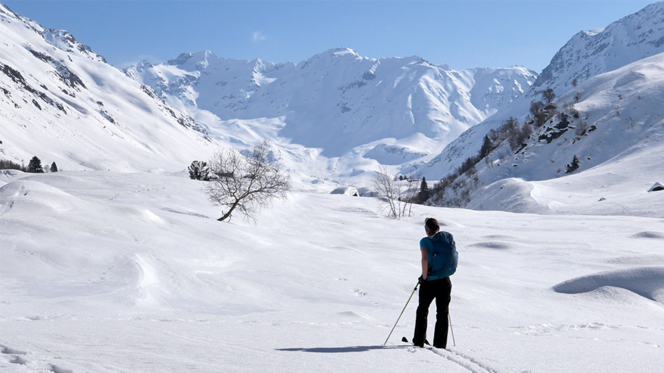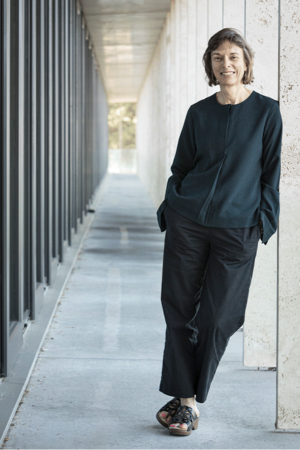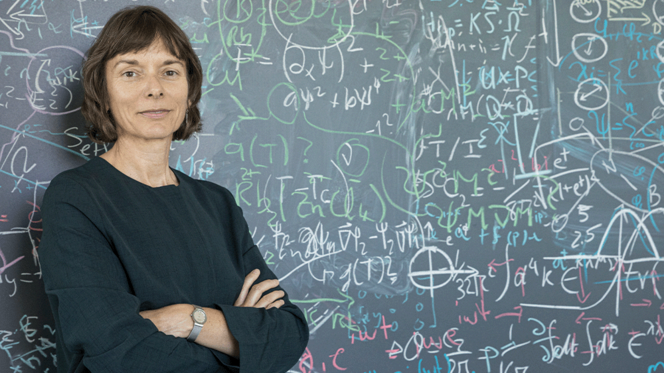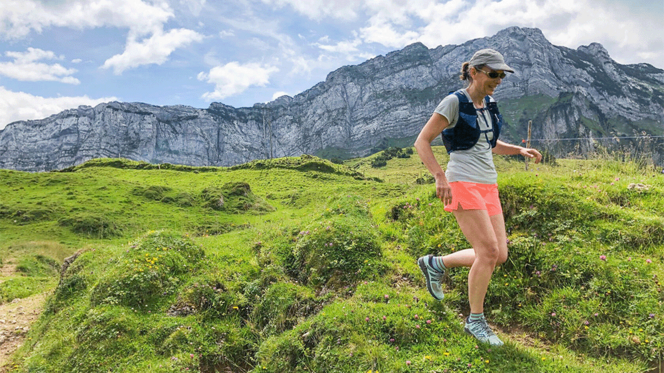Nicola Spaldin
The pioneer of multiferroica research

In an interview, the winner of the Hamburg Prize for Theoretical Physics 2022 explains what drives her in her research and what role outdoor activities and music play in her life.
In 2000, the British materials researcher Nicola Spaldin laid the foundation for targeted research into a new class of high-tech materials with a groundbreaking technical article. The crystalline chemical compounds, later christened multiferroics, combine interesting electrical and magnetic properties and open up fascinating potential applications in microelectronics. With her curiosity and determination, Nicola Spaldin gave the starting signal for this booming research field more than 20 years ago. She has received many awards for her fundamental work on the theory of multiferroics.
They were born in 1969 in the northern English city of Sunderland. Your parents liked outdoor activities. Is that why you still appreciate hiking, climbing and mountaineering in your free time?
During my childhood and youth we spent all our family vacations and also many weekends in the countryside and in nature. We went hiking in the summer and skiing in the winter. I'm sure as a kid I often complained about it because it was usually cold and raining outside. But in the end I got hooked on hiking and mountaineering. I didn't start rock climbing until the late 1980s, though, when I was studying at Cambridge University. That was also the time when my parents quit their regular jobs and moved to the Lake District to run a hiking center.
You studied natural sciences at Cambridge University, specializing in chemistry and geology. How old were you when you found out that a career as a researcher could be your thing?
I always liked math and science at school. So when I had to choose my major subjects at 16, I took math, physics, chemistry and music. But I don't think I had any idea at that point what it meant to have a career as a scientist or how realistic that even was.
In front of your office at ETH Zurich, where you have held the professorship for materials theory since 2011, there is a piano that you brought with you from Santa Barbara - where you were a professor at the University of California for 14 years before moving to Switzerland. What role does music play in your life?
An important one. Today, I mainly play the clarinet and make chamber music with great enthusiasm. Making music together with friends at home, with a glass of wine and a good dinner - that was what I missed most during the Corona Lockdown. I also play in an amateur orchestra, which is a lot of fun.
What drives your research into multiferroics and other innovative classes of materials such as superconductors that conduct electricity without loss?
Doing scientific research is really fun! Every little child enjoys solving puzzles. And as a researcher, you never have to stop doing it! So I don't feel driven by anything, but do what I enjoy.

What do you think are the three most important applications of multiferroic materials that we will see in the next ten years?
It is difficult to say which materials will find their way into which technologies because many factors beyond the purely scientific play a role. The original technological motivation for multiferroics was that they could be used to control magnetism using electric fields. This is attractive because electric fields consume much less energy than the electric currents commonly used today. Colleagues at chipmaker Intel and the University of Berkeley recently presented a beautiful logic device based on this principle.
Moreover, it has been shown: The special chemistry of multiferroics, which enables magnetism and ferroelectricity, gives them properties that could make many completely unexpected applications possible. For example, splitting water to produce hydrogen as a clean energy carrier. Or the production of environmentally friendly dyes or scaffold structures that regrow bones.
As a professor of materials theory, you regularly work together with experimenters. How important is this cooperation between theory and experiment?
For theoretical materials scientists like me, it is very important to have close and regular contact with colleagues who are doing experiments: both to test our ideas and to work together to detect and explain surprising results in the measured data. The PhD students and postdocs in my team all have an experimental partner with whom they work closely.

You have already received many awards for your groundbreaking work on the theoretical foundations of multiferroic materials. Have the many prizes you have received made your life easier or rather more complicated?
Both and, I would say. Financially, of course, prizes help - many are linked to funding for future research projects. And having won prizes can also help convince review panels that your own ideas, which you described in a research proposal, are worth funding.
On the other hand, the more established you become as a researcher, the more difficult it becomes to carve out time for your own research. I have to work really hard these days to prevent the administrative activities from getting out of hand. But anyway, it's definitely a great confirmation that your colleagues appreciate your work. And I am very grateful to those colleagues who took considerable trouble to prepare my nomination for the Hamburg Prize for Theoretical Physics.
In 2017, you received the €100,000 L'Oreal-UNESCO Prize for Women in Science, which supports outstanding female researchers. Is it still harder for women than for men to make their way to the top in science?
There are a large number of studies documenting that members of groups that are underrepresented in a particular field have a harder time succeeding in that field. As long as women are underrepresented in science, we will continue to face these problems.
The Hamburg Prize for Theoretical Physics entails that you will spend some time in Hamburg to interact with researchers, teachers and students in the Hanseatic city. What do you expect from your stay in Hamburg?
I have many colleagues in Hamburg, and I'm excited to now have an excuse to spend more time discussing and collaborating with them! And I am also looking forward to meeting and interacting directly with students at the University of Hamburg and at DESY. And of course, I'm also planning a visit to the Elbphilharmonie.
